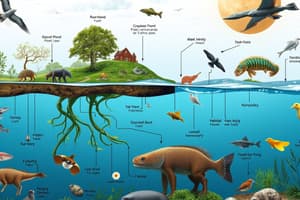Podcast
Questions and Answers
What type of organisms are autotrophs?
What type of organisms are autotrophs?
- Organisms that can only live in water
- Organisms that can produce their own food using light or chemical energy (correct)
- Organisms that obtain energy by oxidation of electron donors
- Organisms that depend on others for food
What distinguishes organotrophs from lithotrophs?
What distinguishes organotrophs from lithotrophs?
- Lithotrophs use organic compounds as electron donors
- Organotrophs can photosynthesize
- Lithotrophs can photosynthesize
- Organotrophs use organic compounds as electron donors (correct)
Which of the following types of organisms utilizes solar energy?
Which of the following types of organisms utilizes solar energy?
- Chemotrophs
- Heterotrophs
- Autotrophs (correct)
- Organotrophs
Most fungi are __________, __________, and __________.
Most fungi are __________, __________, and __________.
What does it mean if an organism uses NO3- as an electron acceptor?
What does it mean if an organism uses NO3- as an electron acceptor?
Match the following biological processes to their function:
Match the following biological processes to their function:
Why would the electron transport chain run 'in reverse'?
Why would the electron transport chain run 'in reverse'?
Calculate the oxidation state of S in the following compounds: SO2-, S0, H2S, S2O42-.
Calculate the oxidation state of S in the following compounds: SO2-, S0, H2S, S2O42-.
Is the transformation of H2S to S0 a reduction or oxidation?
Is the transformation of H2S to S0 a reduction or oxidation?
Which half reaction is most favorable for transforming CH2O to CO2?
Which half reaction is most favorable for transforming CH2O to CO2?
What are most enzymes composed of?
What are most enzymes composed of?
What is the difference between hydrolases and oxidases?
What is the difference between hydrolases and oxidases?
Provide an example of a photoaquatroph.
Provide an example of a photoaquatroph.
Study Notes
Definitions of Trophic Categories
- Autotrophs: Organisms that produce their own food using light (photosynthesis) or chemical energy (chemosynthesis).
- Heterotrophs: Organisms that cannot synthesize their own food and depend on others for nutrition.
Energy Acquisition Strategies
-
Organotrophs: Use organic compounds as electron donors.
-
Lithotrophs: Use inorganic compounds as electron donors.
-
Phototrophs: Obtain energy from sunlight.
-
Chemotrophs: Obtain energy from the oxidation of electron donors, which can be organic (chemoorganotrophs) or inorganic (chemolithotrophs).
Fungi Classification
- Most fungi are classified as:
- Heterotrophs
- Organotrophs
- Chemotrophs
Electron Acceptors and Donors
- An organism using NO3- as an electron acceptor indicates it is a lithotroph, as organotrophs use organic compounds.
Metabolic Pathways Functions
- Electron transport chain: Generates a proton gradient to drive ATP synthase.
- Calvin cycle: Fixes CO2 in autotrophs.
- Krebs/TCA/Citric acid cycle: Produces electron carriers and ATP via substrate-level phosphorylation.
Reverse Electron Transport
- Occurs in chemolithotrophs using electron donors with higher redox potential.
- Supplies energy to reduce NAD(P)+.
- Autotrophs can use this process for inorganic carbon fixation.
Oxidation States of Sulfur Compounds
- SÒ2-: +4
- Elemental S (S0): 0
- H2S: -2
- S2Ǒ2-: -1 (with oxygen at +0.5)
Chromatium Bacteria Processes
- Chromatium transforms H2S to S0 through oxidation, with H2S acting as the electron donor.
Favorable Half Reaction
- When transforming CH2O to CO2, the most favorable half-reaction under standard conditions is:
- O2 + 4H+ + 4e- -> 2H2O due to the largest Eh difference.
Enzyme Composition
- Most enzymes are composed of proteins.
Enzyme Types
- Hydrolases: Catalyze the hydrolysis of chemical bonds (e.g., esterases, nucleases).
- Oxidases: Catalyze oxidation-reduction reactions with dioxygen (e.g., glucose oxidase).
Example of Photoaquatroph
- Cyanobacteria: An example of organisms in this category.
Studying That Suits You
Use AI to generate personalized quizzes and flashcards to suit your learning preferences.
Description
Explore the various trophic categories and energy acquisition strategies in biology. This quiz covers important concepts such as autotrophs, heterotrophs, and the metabolic pathways involved in energy production. Test your knowledge of fungi classification and electron donor-acceptor dynamics.




